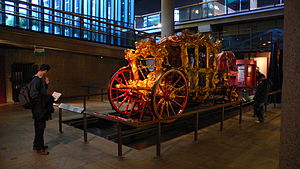Museum of London
 | |
 | |
| Established | 1975 |
|---|---|
| Location | City of London, London EC2, England, United Kingdom |
| Director | Jack Lohman |
| Website | www.museumoflondon.org.uk |

The Museum of London documents the history of London from the Prehistoric to the present day. The museum is located close to the Barbican Centre, and a few minutes walk north of St Paul's Cathedral, overlooking the remains of the Roman city wall and on the edge of the oldest part of London, known as the City, now the financial district. It is primarily concerned with the social history of London and its inhabitants throughout history. Admission is free.
The museum comprises a series of chronological galleries containing original artefacts, models, pictures and diagrams, with a strong emphasis on archaeological discoveries, the built city and urban development and interactive displays and activities for all ages. Due to be completed in 2009, the museum is currently engaged in a major redevelopment to enrich the experience of visiting the galleries. The prehistoric gallery, "London Before London" and the Medieval Gallery have already been updated and in 2007 a new exhibition on the Great Fire of London opened. Star exhibits include the Lord Mayor of London's state coach, and a reconstruction of a street from Victorian London.
In 2003, Museum in Docklands was opened in a 19th-century warehouse building near Canary Wharf on the Isle of Dogs. Museum in Docklands charts the history of London as a port, beginning 2000 years ago with the Roman trading post set up on the banks of the Thames and following London's expansion into the biggest port the world had ever known. It includes the city's first permanent gallery examining London's involvement in the transatlantic slave trade.Docklands.
Fragments of the Roman London Wall can be seen just outside the museum. The Museum of London includes the Museum of London Archaeology Service (MoLAS), which provides archaeological services in London but also does work elsewhere in the UK and abroad. Archaeological findings made by MoLAS and others working in London are archived at the Museum of London's London Archaeological Archive and Research Centre (LAARC).
These are all part of the Museum of London Group and operated by the Corporation of London and Department for Culture, Media and Sport. The museum was opened in 1976, utilising collections previously held by the Corporation at the Guildhall and also items from other collections. Its first director was Tom Hume (Museums), who was succeed by Max Hebditch and, more recently, by Simon Thurley, now the Chief Executive of English Heritage. The current director is Professor Jack Lohman.
See also
External links
- Official website of the Museum of London
- Location map from streetmap.co.uk
- UntoldLondon website - also run from the Museum of London
- Map My London new community website launched by the Museum of London on November 16 2006
